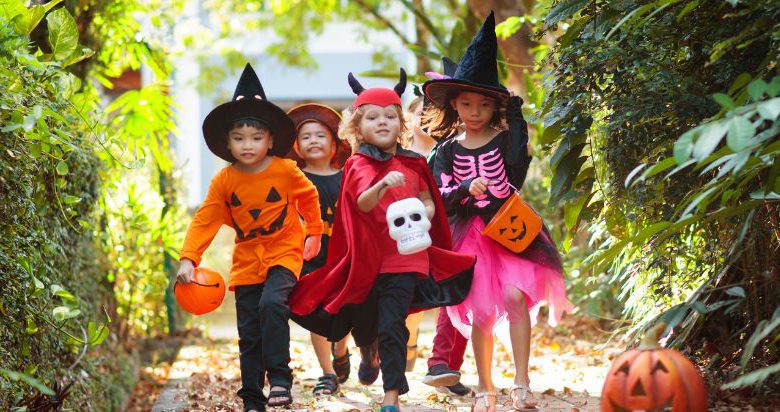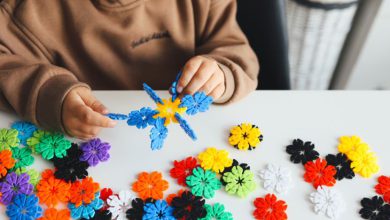Halloween Safety With Young Children

Halloween Safety With Young Children
Halloween is just around the corner! This holiday is a magical time for our little ones, filled with costumes, candy, and spooky fun. However, it can also cause some anxiety for parents trying to keep their children safe, and while trick-or-treating and dressing up can be exciting, all parents can agree that safety should come first. That’s why we’ve gathered some essential Halloween safety tips to help you and your family enjoy a fun and worry-free holiday!
Trick-or-Treating Safety
For children, running up to neighbors’ doors and asking for a sweet treat is the highlight of Halloween. However, it’s important to take a few precautions to keep them safe:
- Accompany young children and stick to familiar areas: Preschool-aged children should always have an adult with them, and it’s best to stay in well-lit, familiar neighborhoods. Keeping to known areas helps prevent getting lost and ensures your child’s safety. It’s a good idea to plan a trick-or-treating route ahead of time and to only approach houses with porch lights on. This simple rule can help signal which homes are welcoming to trick-or-treaters and help avoid areas that are too dark or unfamiliar.
- Follow safe pedestrian rules: While the excitement of trick-or-treating can sometimes cause little ones to run ahead, it’s important to teach them basic pedestrian safety. Sadly, according to Safe Kids Worldwide, children are more than twice as likely to be hit by cars on the night of Halloween. Always walk on sidewalks (or on the far edge of the road, facing traffic if no sidewalks are available), use crosswalks when crossing streets, and hold hands with your child when crossing. Reminding kids to stop at corners, look both ways, and avoid running can prevent accidents and keep trick-or-treaters safe.
- Inspect all treats before eating: While young children will likely be eager to dive into their candy bags as soon as they get home, take a moment to check for any tampered wrappers or potential allergens. The U.S. Food and Drug Administration (FDA) suggests discarding any homemade treats from unknown sources and closely inspecting pre-packaged candy for any signs of tampering. This is particularly important for children with food allergies. Parents should also be aware of the ingredients in the candies to avoid allergens like nuts, dairy, or gluten.
- Closely monitor children for dehydration or upset stomachs: While it’s easy to focus on keeping children safe from external dangers, parents should also be mindful of their child’s overall health during the holiday. Trick-or-treating often involves a lot of walking, so ensure your little one stays hydrated and wears comfortable shoes. Additionally, limit the amount of candy they consume in one night to avoid upset stomachs. Offering a filling dinner before trick-or-treating can reduce candy cravings throughout the evening.
Costume Safety
Halloween costumes are all about creativity, but they need to be practical, too! Here are some costume safety tips to keep in mind:
- Choose flame-resistant costumes: When selecting your child’s costume, make sure it’s made from flame-resistant materials like polyester or nylon. This reduces the risk of the costume catching fire from candles or decorations. Long capes or costumes that drag on the ground can also pose a tripping hazard. Confires Fire Protection Service suggests being mindful of the fabrics and lengths of costumes, and to consider avoiding oversized accessories that could easily snag on objects or cause accidents.
- Ensure proper visibility with masks and face paint: While masks can complete a costume, they often obstruct a child’s vision, increasing the risk of falls or accidents. Instead, consider using non-toxic face paint or makeup, which allows your child to see clearly. It is best to avoid masks with small eye holes. If using face paint, test face paint on a small patch of skin first to ensure your child doesn’t have an allergic reaction.
- Reflective gear and glow sticks for visibility: Halloween festivities often last into the evening, so it’s important to ensure that your child is easily visible in the dark. Adding reflective tape or stickers to their costumes or candy bags can help drivers spot them. Glow sticks or small flashlights are another great option for keeping them visible, and they can even add a fun, spooky effect to costumes. According to Safe Kids Worldwide, bright or reflective accessories reduce the risk of pedestrian accidents and make your child easier to see.
- Comfort is key: While it’s tempting to choose elaborate costumes, remember that your preschooler will likely be wearing it for several hours. Make sure the costume is comfortable, isn’t too tight or itchy, and allows for free movement. Comfortable shoes are a must, and it’s a good idea to layer clothing underneath if it’s a chilly evening. Overly elaborate costumes with multiple pieces or heavy accessories can weigh a child down and make them tired quickly.
How to Safely Prepare Your House for Trick-or-Treaters
If you plan on welcoming trick-or-treaters to your home, it’s important to make sure your property is safe and accessible:
- Keep walkways clear of hazards: To ensure a safe experience for trick-or-treaters visiting your home, make sure your yard, driveway, and porch are well-lit and free of tripping hazards like toys, hoses, or decorations. It’s important to remove anything that could cause someone to trip, such as outdoor furniture or garden tools. Illuminating your walkway with lanterns or string lights is a festive and practical way to ensure your home is safe for visiting children.
- Pet safety precautions: While pets may enjoy the excitement of Halloween, the constant ringing of the doorbell and the presence of strangers can be overwhelming for them. For the safety of both pets and visitors, the ASPCA recommends keeping pets in a secure, quiet area of the home during trick-or-treating hours. Even the friendliest pets can become frightened by costumed visitors and may act out of character, leading to accidental bites or escapes.
- Consider allergy-safe treats: If you’re handing out candy, consider providing non-food treats for children with allergies. Participating in the Teal Pumpkin Project (described in greater detail below) is a great way to show families that your home offers safe alternatives for children with food allergies. Simply place a teal-colored pumpkin outside your door to signal that you’re offering non-food treats.
Food Allergies and Safe Treats
For families with children who have food allergies, Halloween can be a bit more stressful. Thankfully, there are plenty of ways to make Halloween safer and more inclusive for everyone:
- Participate in the Teal Pumpkin Project: If you haven’t heard of the Teal Pumpkin Project, it’s an initiative started by Food Allergy Research & Education (FARE) to help ensure that all children, including those with food allergies, can participate in trick-or-treating. By offering non-food treats, you can help create a safer and more inclusive environment for all children. It’s as simple as placing a teal pumpkin outside your home to indicate that you’re participating. Non-food treats can be anything from stickers to small toys or even glow sticks!
- Always read labels: For parents of children with food allergies, it’s crucial to read the labels of all treats before allowing them to indulge. Many common Halloween candies contain allergens like peanuts, tree nuts, dairy, or gluten, and some candies may not have clear labeling. The FARE website offers helpful tips on what to look for in ingredient lists and how to ensure your child’s safety while still enjoying the holiday. If in doubt, stick to candies that are known to be safe or opt for non-food treats.
- Be prepared for food allergy emergencies: Even with careful planning, accidents can happen. If your child has severe food allergies, make sure to carry an epinephrine auto-injector and have it easily accessible while trick-or-treating. Let your child’s friends and the adults supervising them know about their allergies and be vigilant about checking treats before consumption.
Conclusion
Halloween is a memory your children will cherish into their adulthoods, and as parents, we play an important role in ensuring it’s a happy and secure memory. From trick-or-treating safety to costume considerations, following these simple Halloween safety tips can help you and your little one enjoy a fun and memorable holiday. Little Sunshine’s wishes you all a spooky and safe Halloween!
If you found this week’s blog helpful, be sure to check out these as well:
- Safety at School for Children with Food Allergies
- Electrical Safety During the Holidays: Tips from Little Sunshine’s Playhouse





